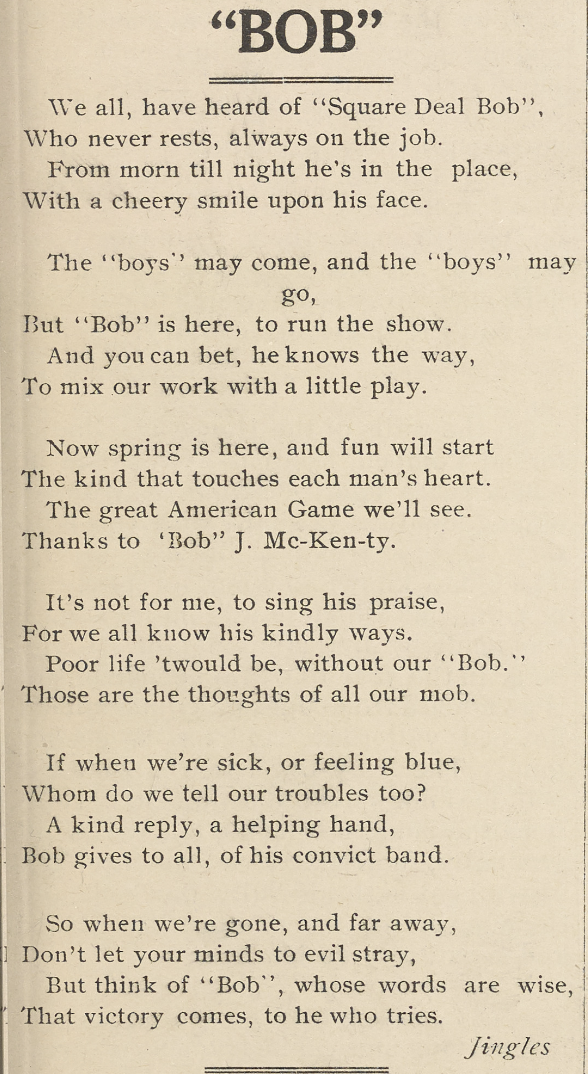Established 2023
The People Behind the Products.
Monday, November 11, 2024
Gracie Smith
Introduction

This is an image of an ad section from The Umpire
When we think about prisons, including Eastern State Penitentiary, we often imagine seclusion and suffering, rather than freedom of expression or creativity. However, the pages of The Umpire, a newspaper publication from within the prison walls, reveal a different story. A story where incarcerated individuals were free to use their skills and creativity to make homemade products that could be bought and sold. This aspect of prison life, which tends to be overlooked, highlights the adaptability and humanity of these individuals, who, even in captivity, found ways to be an instrumental part of their community by expressing themselves in impactful ways. Through their creations and trades, they built for themselves a sense of purpose and bond that pushed past their current circumstances, challenging the belief of prison as solely correctional. Pictured above is an example of an ad section in The Umpire that portrays items for sale in and around 1913.
Edward Franklin

This is an image of a Christmas card from 1913

This is an example poem written by Jingles
Edward Franklin, better known as "Jingles," was a passionate poet from New York City whose talents reached far beyond poetry. His love for creating and sharing his passions did not end following his sentencing. At the age of 24, Edward continued to focus his creativity into writing heartfelt poems, which can be seen by the image on the right, and making cards that brought moments of light to his peers. Jingles’s poems were published a number of times throughout his time at Eastern State which implies that his work was well received. These poems, as seen by the example, were often positive and upbeat, offering a lighthearted outlet for readers. The example poem describes “Bob,” who we can assume is a fellow incarcerated person at Eastern State who led a convict band. Through his band, Bob fostered a spirit of companionship and demonstrated how individuals used their talents to create feelings of hope and positivity. Through his poems and cards, Jingles spread joy, reminding everyone around him that their lives held meaning far beyond the physical prison walls. His cards celebrated holidays, milestones, and small triumphs, helping his fellow inmates feel connected to a world that often felt far off. Jingles’ efforts highlighted the need for community and love, even in the most isolated circumstances. His legacy portrays how creativity and human connection can flourish in unlikely places, challenging the belief of prison as solely a place of punishment and correction.
Peter Marcelis

This is an image of a woman wearing a scarf in the early 20th century.
Peter Marcelis of Philadelphia, PA, spent his time at Eastern State Penitentiary creating scarves, shawls, and ball tidies, a meaningful tool that held balls of yarn and thread. He was thoughtful in creating these goods unique to the buyer, as he offered multiple color options and personalized designs. These handmade scarves and shawls did more than provide warmth within the cold prison walls. The uniqueness of each allowed for incarcerated persons to feel a sense of individuality which was often hard to find in isolated environments such as penitentiaries. The freedom to choose was refreshing when surrounded by so much direction and order. In addition, some were gifted to loved ones outside, offering a physical connection to those they missed. Through his crafts, Peter created an environment of comfort and connectivity, bridging the gap between incarcerated life and the outside world.
Conclusion

This is an image of an incarcerated person at Eastern State painting in his cell.
Life at Eastern State in the early twentieth century was much more than just confinement. Incarcerated individuals like Edward and Peter found ways to express their passions and creativity, fostering connection and a sense of belonging among their peers. These various talents and crafts highlight that, even within prison walls, individuals continue to find purpose and contribute to their communities as well as have the ability to be themselves and make choices that were important to them and their happiness. As humans, we are driven to share our talents, and it’s important to recognize and celebrate these individuals as part of a larger community. By honoring their resilience and creativity, we attest that their lives hold meaning, reminding us that human love and connection can flourish, even in the most challenging places.
Citation: All of these photos are pre-1920 and therefore are under fair use.
